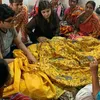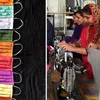From observation to originality: creativity insights from the Chitra Santhe 2021 artists
In our third photo essay on the annual Chitra Santhe art festival, we feature more artist insights and stunning artworks.
Launched in 2014, PhotoSparks is a weekly feature from YourStory, with photographs that celebrate the spirit of creativity and innovation. In the earlier 505 posts, we featured an art festival, cartoon gallery. world music festival, telecom expo, millets fair, climate change expo, wildlife conference, startup festival, Diwali rangoli, and jazz festival.
The annual Chitra Santhe exhibition, now in its 18th edition, features the works of 1,500 artists from 19 states in India and 25 countries around the world. Hosted by Karnataka Chitrakala Parishath in Bengaluru, the virtual exhibition is being held till the end of January. The festival website provides artist contact information and artwork prices.
In this photo essay series, we profile a range of artworks along with insights from the participating artists. See Part I and Part II of our coverage, featuring Somya Pathak, Aiko Higuchi, Edem Elesh, Geeta Arya, Archana Patil, Bharathi Senthilvelan, Dariusz Kaca, and William Dayabaran.
See also YourStory’s coverage of six earlier editions of Chitra Santhe: 2020, 2019, 2018, 2017, 2016, and 2015, as well as compilations of Top Quotes of 2020 on Art in the Era of the Pandemic, Indian Art, Art Appreciation and Practice, and Beauty and Business of Art.

Artist: Chitra Hariharan
Harini Narayan
“My art is influenced by my life's journey and my response to some of the happiest moments,” explains Harini Narayan, in a chat with YourStory. She started off as a doctor in Bengaluru, completed post-graduation from Mangalore University, and then moved to the UK.
She enthuses: “I have been out of Bengaluru for 40 years. I have now returned to my roots to India and Bengaluru, and to my first love: ART!”
“My long career as a doctor has given me deep insight into observing people,” Harini says. The smallest nuance, such as a fleeting glance, a smile, or a frown, a gesture can all carry a mood and tell a story. “This is what I attempt to capture in my art. Each painting carries a memory and tells a story,” she describes.
Harini’s other passions are in-depth study of ancient civilisations, archaeology, and scuba diving in oceans around the world. “My archaeological pursuits have driven me to undertake several solo unaccompanied journeys to some of the most remote, even dangerous parts of the world away from any tourist trail,” she says.
She experiences and records the fast disappearing sites, and her paintings have been inspired by chance encounters during such journeys. “My marine paintings reveal glimpses of totally alien life forms that share our planet, bur are rarely seen,” Harini proudly says. She also has an ongoing exhibition at Karnataka Chitrakala Parishath, based on her travel encounters.

Artist: Harini Narayan
Harini’s idea of success as an artist is to inspire viewers to pause and look more carefully at the world around. “Success is in sharing my passion for unusual places and amazing people. I feel blessed that we continue to share this planet despite the troubles and challenges that face us,” she explains.
She values her art and does not price it as per conventional demands. “Awards are also important. Like any artist, I would want the society to appreciate the artwork both for its technical craftsmanship as well as the passion that created it,” she adds. “Art appreciation differs with each culture, each country, each set of people, and with changing times and economic influences,” she observes.
“After my return to India, my personal observation has been that calendar art is what is most appreciated, followed by repetitive themes of sensuous women, a theme that has not changed for probably several millennia in art and sculpture,” Harini says.
“If one formula is seen to work, there seems to be a trend to produce hundreds of artworks on the same theme or variants of the same ‘School of Art,’” she observes.
“At the other end, in order to break away from the safety of convention, abstract art that tries to mimic Western abstraction has also been mass-produced, again without much soul,” Harini laments.
“Art appreciation needs to learn to identify genuine individuality rather than gimmickry. Till art appreciation grows up in India, buyers will not risk investing in newcomers. This is a great pity as talent is limitless in India,” she cautions.
At Chitra Santhe, Harini exhibited works on the theme COVID Warriors, based on her work in the UK healthcare sector and what she saw on TV. “The desperation I felt on a personal level and the empathy for the poor migrant workers walking on foot were expressed in two of my works,” she explains.
“The pandemic affected me quite severely as a doctor in the UK, facing an unknown killer during the first wave of the pandemic,” she recalls.
However, it also brought her much closer to colleagues and far-flung friends around the world. “I continued to work, to paint, and look after the safety of my elderly mother with the belief that millions are far worse off than I was. I needed to continue for them rather than just for me,” she says.

Artist: Appanna N Pujari
Online exhibitions are a mixed experience for artists and art lovers. “I am still unsure about online exhibitions that lack the physicality of an artwork that I can ‘feel’ just a few feet from my face,” Harini says. “It is probably the difference between the sensation of darshan of a deity while visiting a temple, and its depiction in calendar art,” she jokes.
“I have stood in front of Rembrandt's Nightwatch for the first time in Amsterdam and found tears rolling down my cheeks, though I had seen the painting in prints years before,” she recalls.
“That is the true power of art. I am sorry to say that online exhibitions could never achieve the experience of a live show, and can be only a second-best alternative,” Harini says.
“Trust in your individual talents and drives that inspire you, which may be far removed from the taught theory or ‘school of art,’” she advises aspiring artists. “Learn to look without prejudice at art. Recognise that art transcends all borders, societal groupings, or historical time zones,” Harini emphasises.
Gayatri Sivaramakrishnan
“Art is like meditation which helps me connect to the Supreme power. It is during a certain low phase of my life that I started taking painting lessons as a diversion, with zero expectation,” Gayatri Sivaramakrishnan recalls.
“However, I was delightfully surprised to see the healing effects this beautiful hobby bestowed on my overall well-being. In this fast-paced life, when everything is run by the clock, art has the ability to stop time and make us enjoy every moment of creativity,” she enthuses.
Gayatri sees success as coming from the inner joy as well as recognition and appreciation from others, and an increase in demand for her work. She calls for more art appreciation in society through education and art fairs that showcase local and global talent.

Artist: Gayatri Sivaramakrishnan
At Chitra Santhe, she exhibited the Kerala mural titled Dhanvantri. “According to mythology, he is the God of Medicine who emerged from the milk ocean bringing with him nectar and medicinal herbs,” she explains.
She says she took extra efforts to depict the calm and serene face of the God, which will instill faith and remove fear of the pandemic. Her artworks are priced from Rs 6,000 to Rs 15,000.
“Painting is my way of finding solace in these chaotic times. The increased workload at home due to kids' online classes has made it difficult to get that full chunk of uninterrupted time I used to get earlier in pre-COVID times,” Gayatri explains.
She appreciates the opportunity that the online exhibition gives for those who had problems getting to the venue. “It also gives us an opportunity to be seen by people anywhere in the world,” she adds.
“The virtual world is expanding our horizon by bringing everything closer – the school, the office, shopping and now the renowned art exhibition, all just a click away,” Gayatri observes.
“Creativity is contagious. Pass it on,” she jokingly advises aspiring artists.

Artist: Ashrith V
Ashrith V
“Art for me is an inner exploration. It is a spiritual process for me,” Ashrith V explains. “Success for me is self-fulfillment. If I am able to express myself fully with art, that is success for me as an artist,” he adds.
He calls for more public awareness programmes on art like exhibitions. For Chitra Santhe, he prepared works on Lord Shiva. “Shiva as a God has inspired me to explore life from a different perspective. These paintings are expressions of my own inner experiences,” he says.
Ashrith says the pandemic lockdown has helped him know himself more. “I spend this time working on my creativity,” he says. “Spend more time in nature and explore,” he advises aspiring artists.
He regards the online exhibition as the best solution given the current circumstances. “But for proper communication with buyers and sellers, the physical exhibition is better,” Ashrith observes.

Artist: Ashrith V
Binod Pradhan
One of the international artists exhibiting at Chitra Santhe this year is Binod Pradhan. He is also a graphic designer and founder of the Kasthamandap Artists Group of Nepal.
“Art to me means an exploration of the soul. Only when you are close to your own soul do real feelings and the right imagination appear through canvases,” he explains.
Success for him comes from the satisfaction of being able to express such exploration. “Only looking at the number of paintings or awards is a disappointing analysis of an artist’s work,” Binod adds.
He calls for more art appreciation in society through teachings across generations, right from childhood. “Life can be described not just through sound but with the vision of mute pictures,” Binod observes.
“In a world increasingly driven by machines, one should learn to appreciate the skills of working with hands,” he urges.

Artist: Binod Pradhan
For Chitra Santhe, he focused on artworks calling for better environmental preservation and social protection. “Art work can’t be ranged with prices, it is immortal,” Binod says. It is hard for experts to put a value on the imagination, dedication, research and expression of an artist.
“Though the pandemic was a tough time, it also gave artists the golden time to look deeper within themselves and their paintings,” Binod observes. Online exhibitions give opportunity and motivation, but the lack of travel and physical exhibitions comes in the way of realistic interaction.
He advises artists to become closely connected to their own purpose and art types. “This deepens passion, and love for even the small aspects that will appear on canvas,” he says.
“Art is also meditation and perseverance no matter what the circumstances,” Binod signs off.
Now, what have you done today to pause in your busy schedule and find new avenues to apply your creativity?

Artist: Ashok S. Rathod

Artist: Anand Mahadev Bekwad

Artist: Anjana Sengupta

Artist: Asha Sudakar Shenoy

Artist: Ashok Ganguly

Artist: Babu Jattakar

Artist: Basavaraj Achar KR

Artist: Binod Pradhan

Artist: C P Suresh

Artist: Deepali Mundra

Artist: Dipankar Ganguly

Artist: Faazilah T

Artist: Arun Kumar K.V
See also the YourStory pocketbook ‘Proverbs and Quotes for Entrepreneurs: A World of Inspiration for Startups,’ accessible as apps for Apple and Android devices.
Edited by Megha Reddy









